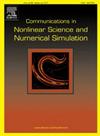Problem optimization of ray tracing through the crystalline lens of the eye with an artificial neural network and Grey Wolf optimizer
IF 3.4
2区 数学
Q1 MATHEMATICS, APPLIED
Communications in Nonlinear Science and Numerical Simulation
Pub Date : 2025-03-04
DOI:10.1016/j.cnsns.2025.108733
引用次数: 0
Abstract
Ray tracing through the crystalline lens of the eye is a complex optical problem traditionally tackled by mathematical techniques that may lack optimal accuracy. This paper introduces a novel method that integrates the Grey Wolf optimizer (GWO) with an artificial neural network (ANN), termed ANNGWO, to enhance the precision of ray tracing through the lens. The ANNGWO approach involves defining a cost function with a multi-layer neural network incorporating three activation functions: Log-sigmoid, Radial basis, and Tan-sigmoid. GWO is then employed to optimize this cost function, effectively simulating the intricate geometry of the crystalline lens. The methodology includes designing a multi-layer ANN with the activation function to model the ray tracing problem.This is followed by constructing the cost function by formulating the unsupervised error function for the equation and its initial conditions. Subsequently, GWO is utilized to minimize this cost function, thereby enhancing the accuracy of the simulation. The performance of ANNGWO is compared with traditional methods, including the Laplace decomposition method (LDM), multi-step differential transform method (MDTM), and the fourth-order Runge–Kutta method (RKM). Numerical experiments demonstrate that ANNGWO significantly improves accuracy. For instance, the mean absolute error (AE) using the Log-sigmoid activation function is for 10 neurons. Best-case AE values range from to , outperforming traditional methods. Additionally, ANNGWO exhibits consistently lower standard deviation of absolute error across all time steps, reflecting enhanced stability. Compared to LDM, MDTM, and RKM, ANNGWO achieves a significant reduction in error, underscoring its superior precision and reliability. The method’s ability to avoid local minima and its robust convergence behavior make it a powerful tool for simulating light movement in the eye, with promising applications in vision research and ocular imaging.
求助全文
约1分钟内获得全文
求助全文
来源期刊

Communications in Nonlinear Science and Numerical Simulation
MATHEMATICS, APPLIED-MATHEMATICS, INTERDISCIPLINARY APPLICATIONS
CiteScore
6.80
自引率
7.70%
发文量
378
审稿时长
78 days
期刊介绍:
The journal publishes original research findings on experimental observation, mathematical modeling, theoretical analysis and numerical simulation, for more accurate description, better prediction or novel application, of nonlinear phenomena in science and engineering. It offers a venue for researchers to make rapid exchange of ideas and techniques in nonlinear science and complexity.
The submission of manuscripts with cross-disciplinary approaches in nonlinear science and complexity is particularly encouraged.
Topics of interest:
Nonlinear differential or delay equations, Lie group analysis and asymptotic methods, Discontinuous systems, Fractals, Fractional calculus and dynamics, Nonlinear effects in quantum mechanics, Nonlinear stochastic processes, Experimental nonlinear science, Time-series and signal analysis, Computational methods and simulations in nonlinear science and engineering, Control of dynamical systems, Synchronization, Lyapunov analysis, High-dimensional chaos and turbulence, Chaos in Hamiltonian systems, Integrable systems and solitons, Collective behavior in many-body systems, Biological physics and networks, Nonlinear mechanical systems, Complex systems and complexity.
No length limitation for contributions is set, but only concisely written manuscripts are published. Brief papers are published on the basis of Rapid Communications. Discussions of previously published papers are welcome.
 求助内容:
求助内容: 应助结果提醒方式:
应助结果提醒方式:


